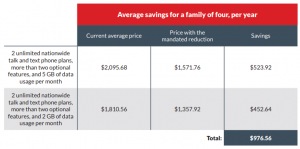Minding the gap
There are still too many Canadian households who lack access to sufficient broadband connectivity.
For many, there are connectivity options available for high speed internet, but not at the CRTC’s aspirational target speed and perhaps not at a price that all consumers are willing to pay. As Canadians enter the 6th week of isolation to slow the spread of the COVID-19 virus, we have become more acutely aware of the gap between the majority of households with broadband internet and those unfortunate homes who lack connectivity.
Thanks to the leadership of service providers like Rogers and TELUS, devices and connections are being made available for free or for very low prices for low income households, students and vulnerable groups. A detailed list of initiatives by various service providers are described in a blog post by the Canadian Wireless Telecommunications Association.]
How do we extend the availability of faster broadband service to more Canadian households located in more sparsely populated regions of the country, with many living in especially challenging geographies?
Billions of dollars have already been spent, and billions more will need to be spent by government and the private sector in order to meet the objectives set by the CRTC in 2016.
I’m not sure I have seen a CRTC document as widely misquoted or misunderstood as Telecom Regulatory Policy CRTC 2016-496, “Modern telecommunications services – The path forward for Canada’s digital economy“. In this document, the CRTC updated its universal service objective, adding broadband service to the definition.
Canadians, in urban areas as well as in rural and remote areas, have access to voice services and broadband Internet access services, on both fixed and mobile wireless networks. To measure the successful achievement of this objective, the Commission has established several criteria, including,
- Canadian residential and business fixed broadband Internet access service subscribers should be able to access speeds of at least 50 megabits per second (Mbps) download and 10 Mbps upload, and to subscribe to a service offering with an unlimited data allowance; and
- the latest generally deployed mobile wireless technology should be available not only in Canadian homes and businesses, but on as many major transportation roads as possible in Canada.
This was not expected to happen over night. At the time of the CRTC’s policy decision (December 21, 2016), the CRTC estimated that 82% of Canadians had “access to fixed broadband Internet access services at speeds of at least 50 Mbps download and 10 Mbps upload.” By the end of 2017, that figure rose to 84.1% and by the end of 2018, 85.7% of Canadian households had access to such speeds. The policy decision set an objective for 90% of households to have such access by the end of 2021, a target well within reach, given the current rate of expanded service.
The CRTC expected that it would take 10-15 years to cover the remaining 10% of households, but specifically said it expected “that intermediate steps will be taken to progress towards these goals.” As I have written before, the CRTC’s philosophy has always been that some broadband internet is better than nothing. CRTC reports indicate that by the end of 2018, 89% of Canadians subscribed to an internet service. As such, a number of proposed rural and remote broadband expansion projects may introduce service with speeds of 25 Mbps down and 5 Mbps up, half of the aspirational target.
The CRTC’s Broadband Fund has a call for funding applications now closing on June 1. The application deadline was delayed for the second time yesterday; it was initially March 27 and then April 30. If the June 1 date holds, the applications will be submitted nearly three and a half years after the idea of a CRTC administered Broadband Fund was first announced.
According to the latest CRTC Communications Monitoring Report, as of the end of 2018, approximately 1 in 10 households did not have a residential internet service. But, 99% of Canadians had access to LTE mobile service, and 95% of households had access to LTE-Advanced – which has the ability to deliver a superior broadband experience.
Some might ask, why we aren’t simply using mobile broadband for residential service?
The challenge is that there are cost limitations associated with providing mobile broadband, especially in rural areas. Mobile networks are engineered to provide both coverage and capacity. In rural areas, the initial priority is to provide coverage and many service providers accomplish this using lower band spectrum which can cover a lot of territory from a single tower; based on demand, the mobile networks are reinforced with additional towers and using additional spectrum bands. Because of the lower density of the population, for mobile use it is often sufficient to design the mobile network for coverage without challenging the inherent capacity constraints of the network antenna.
However, residential internet typically generates 10-20 times the traffic of a mobile device, driven primarily by streaming video applications. It wouldn’t take too many residential users to overwhelm the capacity of a cell. It isn’t enough to simply have a signal. There has to be enough capacity built. In some rural areas, some mobile carriers have specifically engineered their networks to be able to handle the loads from fixed residential services and can then offer wireless home internet.
Wireless technology is an important solution for expanding broadband access in rural and remote settings in an economic way. Mobile service providers and some regional wireless ISPs are deploying a variety of affordable wireless broadband solutions using licensed and unlicensed spectrum. A number of service providers are offering download speeds of 25 Mbps using LTE in a fixed wireless application. For the past 6 weeks, I have been using Xplornet’s LTE and getting faster speeds than my neighbours are getting with DSL-based service.
Canada’s mobile and fixed wireless networks are able to provide coverage for nearly every household in Canada. The biggest challenge is expanding capacity cost effectively to accommodate the kinds of traffic most households would want to generate, using comparable applications to those available in urban homes. Will sufficient spectrum be available for rural broadband applications?
When the Auditor General reviewed the history of government-funded broadband expansion programs, the report identified that “ISED did not implement its broadband improvement program in a way that ensured the maximum broadband expansion for the public money spent.” Would wireless solutions help?
As the CRTC takes the next step with its Broadband Fund, and various provinces join ISED in funding broadband initiatives, we should ask if there is an overall rural broadband expansion strategy? Is there a fundamental objective to maximize the number of households for the public money spent? If not, what is the criteria for judging the merits of one application over another?
In the US, the FCC has taken a number of steps over the past few weeks to help allocate spectrum to service providers prepared to expand rural access during these extraordinary times, such as granting temporary spectrum access to Verizon. It also opened the 6 GHz band for WiFi and other unlicensed uses.
How do we ensure that more spectrum is made available by the Canadian government in a timely way to enable service providers to expand rural and remote fixed broadband access?



